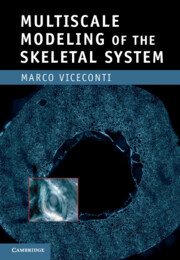4 - Organ level
the bones
Published online by Cambridge University Press: 05 January 2012
Summary
A description of the anatomy and the physiology of bones, and the methods used to model whole-bone biomechanics, in order to predict displacements, stresses, and strains induced by loads acting on the skeleton.
Bone anatomy
The body of vertebrates is supported by an endoskeleton made of connective tissue in cartilaginous and mineralized form. The latter is organized in rigid organs called bones. Bones are organs in the full sense: while we tend to imagine them as inert things, each bone is a true organ made of specialized cellular populations, a complex extracellular matrix, a sophisticated vascular system, and an extensive innervation that is still the subject of investigation.
A first classification of bones is related to their location in the body. Following Gray’s Anatomy (Gray, 1918), we can distinguish between the axial skeleton (vertebral column, thorax, skull) and the appendicular skeleton (upper and lower extremities). A third, separate, group is that formed by the auditory ossicles. The vertebral column includes the entire spine (cervical, thoracic, and lumbar), the sacrum and the coccyx; the thorax includes the sternum and the ribs; the skull includes all cranial and facial bones, down to the hyoid bone in the throat; the ossicles are the middle ear bones, tiny bony structures that transmit sound inside the ear. The upper extremities can be further divided into the shoulder girdle, the arm, and the hand; the lower extremities into the pelvis, leg, and foot. Overall, a normal adult has 206 distinct bones. A child’s skeleton has a much larger number (around 300), but a number of small bones fuse during growth.
- Type
- Chapter
- Information
- Multiscale Modeling of the Skeletal System , pp. 77 - 106Publisher: Cambridge University PressPrint publication year: 2011



